Phenolic Profiles and Antioxidant Activities of 30 Tea Infusions from Green, Black, Oolong, White, Yellow and Dark Teas
Abstract
1. Introduction
2. Materials and Methods
2.1. Chemicals
2.2. Sample Preparation
2.3. Detection of Antioxidant Capacity and Total Phenolic Content (TPC)
2.4. High-Performance Liquid Chromatography (HPLC) Analysis
2.5. Statistical Analysis
3. Results
3.1. Antioxidant Capacities of Tea Infusions
3.2. Total Phenolic Content of Tea Infusions
3.3. Correlations between Values of Ferric-Reducing Antioxidant Power (FRAP), Trolox Equivalent Antioxidant Capacity (TEAC), and TPC
3.4. Phenolic Profiles of Tea Infusions
4. Discussion
5. Conclusions
Author Contributions
Funding
Conflicts of Interest
References
- Pastoriza, S.; Perez-Burillo, S.; Angel Rufian-Henares, J. How brewing parameters affect the healthy profile of tea. Curr. Opin. Food Sci. 2017, 14, 7–12. [Google Scholar] [CrossRef]
- Zhao, F.; Lin, H.; Zhang, S.; Lin, Y.; Yang, J.; Ye, N. Simultaneous determination of caffeine and some selected polyphenols in Wuyi Rock Tea by high-performance liquid chromatography. J. Agric. Food Chem. 2014, 62, 2772–2781. [Google Scholar] [CrossRef] [PubMed]
- Samavat, H.; Newman, A.R.; Wang, R.W.; Yuan, J.M.; Wu, A.H.; Kurzer, M.S. Effects of green tea catechin extract on serum lipids in postmenopausal women: A randomized, placebo-controlled clinical trial. Am. J. Clin. Nutr. 2016, 104, 1671–1682. [Google Scholar] [CrossRef] [PubMed]
- Chen, I.J.; Liu, C.Y.; Chiu, J.P.; Hsu, C.H. Therapeutic effect of high-dose green tea extract on weight reduction: A randomized, double-blind, placebo-controlled clinical trial. Clin. Nutr. 2016, 35, 592–599. [Google Scholar] [CrossRef] [PubMed]
- Ide, K.; Yamada, H.; Takuma, N.; Park, M.; Wakamiya, N.; Nakase, J.; Ukawa, Y.; Sagesaka, Y.M. Green tea consumption affects cognitive dysfunction in the elderly: A pilot study. Nutrients 2014, 6, 4032–4042. [Google Scholar] [CrossRef] [PubMed]
- Takahashi, M.; Miyashita, M.; Suzuki, K.; Bae, S.; Kim, H.K.; Wakisaka, T.; Matsui, Y.; Takeshita, M.; Yasunaga, K. Acute ingestion of catechin-rich green tea improves postprandial glucose status and increases serum thioredoxin concentrations in postmenopausal women. Br. J. Nutr. 2014, 112, 1542–1550. [Google Scholar] [CrossRef] [PubMed]
- Li, S.; Gan, L.Q.; Li, S.K.; Zheng, J.C.; Xu, D.P.; Li, H.B. Effects of herbal infusions, tea and carbonated beverages on alcohol dehydrogenase and aldehyde dehydrogenase activity. Food Funct. 2014, 5, 42–49. [Google Scholar] [CrossRef] [PubMed]
- Li, F.; Li, S.; Li, H.B.; Deng, G.F.; Ling, W.H.; Xu, X.R. Antiproliferative activities of tea and herbal infusions. Food Funct. 2013, 4, 530–538. [Google Scholar] [CrossRef]
- Kim, H.S.; Quon, M.J.; Kim, J.A. New insights into the mechanisms of polyphenols beyond antioxidant properties; lessons from the green tea polyphenol, epigallocatechin 3-gallate. Redox Biol. 2014, 2, 187–195. [Google Scholar] [CrossRef]
- Lv, H.P.; Zhang, Y.; Shi, J.; Lin, Z. Phytochemical profiles and antioxidant activities of Chinese dark teas obtained by different processing technologies. Food Res. Int. 2017, 100, 486–493. [Google Scholar] [CrossRef]
- Zhang, C.; Suen, C.; Yang, C.; Quek, S.Y. Antioxidant capacity and major polyphenol composition of teas as affected by geographical location, plantation elevation and leaf grade. Food Chem. 2018, 244, 109–119. [Google Scholar] [CrossRef] [PubMed]
- Zhang, Y.T.; Li, Q.; Xing, H.; Lu, X.F.; Zhao, L.S.; Qu, K.K.; Bi, K.S. Evaluation of antioxidant activity of ten compounds in different tea samples by means of an on-line HPLC-DPPH assay. Food Res. Int. 2013, 53, 847–856. [Google Scholar] [CrossRef]
- Atoui, A.K.; Mansouri, A.; Boskou, G.; Kefalas, P. Tea and herbal infusions: Their antioxidant activity and phenolic profile. Food Chem. 2005, 89, 27–36. [Google Scholar] [CrossRef]
- Zhang, H.M.; Wang, C.F.; Shen, S.M.; Wang, G.L.; Liu, P.; Liu, Z.M.; Wang, Y.Y.; Du, S.S.; Liu, Z.L.; Deng, Z.W. Antioxidant phenolic compounds from Pu-erh Tea. Molecules 2012, 17, 14037–14045. [Google Scholar] [CrossRef] [PubMed]
- Jeszka-Skowron, M.; Krawczyk, M.; Zgola-Grzeskowiak, A. Determination of antioxidant activity, rutin, quercetin, phenolic acids and trace elements in tea infusions: Influence of citric acid addition on extraction of metals. J. Food Compos. Anal. 2015, 40, 4070–4077. [Google Scholar] [CrossRef]
- Yang, J.; Liu, R.H. The phenolic profiles and antioxidant activity in different types of tea. Int. J. Food Sci. Tech. 2013, 48, 163–171. [Google Scholar] [CrossRef]
- Ghiselli, A.; Serafini, M.; Natella, F.; Scaccini, C. Total antioxidant capacity as a tool to assess redox status: Critical view and experimental data. Free Radic. Biol. Med. 2000, 29, 1106–1114. [Google Scholar] [CrossRef]
- Fernandez-Panchon, M.S.; Villano, D.; Troncoso, A.M.; Garcia-Parrilla, M.C. Antioxidant activity of phenolic compounds: From in vitro results to in vivo evidence. Crit. Rev. Food Sci. 2008, 48, 649–671. [Google Scholar] [CrossRef]
- Tang, G.Y.; Zhao, C.N.; Xu, X.Y.; Gan, R.Y.; Cao, S.Y.; Liu, Q.; Shang, A.; Mao, Q.Q.; Li, H.B. Phytochemical composition and antioxidant capacity of 30 Chinese teas. Antioxidants 2019, 8, 180. [Google Scholar] [CrossRef]
- Benzie, I.F.F.; Strain, J.J. The ferric reducing ability of plasma (FRAP) as a measure of “Antioxidant power”: The FRAP assay. Anal. Biochem. 1996, 239, 70–76. [Google Scholar] [CrossRef]
- Re, R.; Pellegrini, N.; Proteggente, A.; Pannala, A.; Yang, M.; Rice-Evans, C. Antioxidant activity applying an improved ABTS radical cation decolorization assay. Free Radic. Biol. Med. 1999, 26, 1231–1237. [Google Scholar] [CrossRef]
- Singleton, V.L.; Orthofer, R.; Lamuela-Raventos, R.M. Analysis of total phenols and other oxidation substrates and antioxidants by means of Folin-Ciocalteu reagent. In Oxidants and Antioxidants; Packer, L., Ed.; Elsevier Academic Press Inc.: San Diego, CA, USA, 1999; Volume 299, pp. 152–178. [Google Scholar]
- Cai, Y.; Luo, Q.; Sun, M.; Corke, H. Antioxidant activity and phenolic compounds of 112 traditional Chinese medicinal plants associated with anticancer. Life Sci. 2004, 74, 2157–2184. [Google Scholar] [CrossRef] [PubMed]
- Xu, D.P.; Li, Y.; Meng, X.; Zhou, T.; Zhou, Y.; Zheng, J.; Zhang, J.J.; Li, H.B. Natural antioxidants in foods and medicinal plants: Extraction, assessment and resources. Int. J. Mol. Sci. 2017, 18, 18. [Google Scholar] [CrossRef] [PubMed]
- Liu, Q.; Tang, G.Y.; Zhao, C.N.; Gan, R.Y.; Li, H.B. Antioxidant activities, phenolic profiles, and organic acid contents of fruit vinegars. Antioxidants 2019, 8, 78. [Google Scholar] [CrossRef] [PubMed]
- Higdon, J.V.; Frei, B. Tea catechins and polyphenols: Health effects, metabolism, and antioxidant functions. Crit. Rev. Food Sci. Nutr. 2003, 43, 89–143. [Google Scholar] [CrossRef] [PubMed]
- Zhao, C.N.; Tang, G.Y.; Liu, Q.; Xu, X.Y.; Cao, S.Y.; Gan, R.Y.; Zhang, K.Y.; Meng, S.L.; Li, H.B. Five-Golden-Flowers Tea: Green extraction and hepatoprotective effect against oxidative damage. Molecules 2018, 23, 2216. [Google Scholar] [CrossRef] [PubMed]
- Zhao, C.N.; Zhang, J.J.; Li, Y.; Meng, X.; Li, H.B. Microwave-assisted extraction of phenolic compounds from Melastoma sanguineum fruit: Optimization and identification. Molecules 2018, 23, 2498. [Google Scholar] [CrossRef] [PubMed]
- Li, S.; Li, S.K.; Gan, R.Y.; Song, F.L.; Kuang, L.; Li, H.B. Antioxidant capacities and total phenolic contents of infusions from 223 medicinal plants. Ind. Crop. Prod. 2013, 51, 289–298. [Google Scholar] [CrossRef]
- Guo, Y.J.; Deng, G.F.; Xu, X.R.; Wu, S.; Li, S.; Xia, E.Q.; Li, F.; Chen, F.; Ling, W.H.; Li, H.B. Antioxidant capacities, phenolic compounds and polysaccharide contents of 49 edible macro-fungi. Food Funct. 2012, 3, 1195–1205. [Google Scholar] [CrossRef]
- Lin, Y.S.; Tsai, Y.J.; Tsay, J.S.; Lin, J.K. Factors affecting the levels of tea polyphenols and caffeine in tea leaves. J. Agric. Food Chem. 2003, 51, 1864–1873. [Google Scholar] [CrossRef]
- Carloni, P.; Tiano, L.; Padella, L.; Bacchetti, T.; Customu, C.; Kay, A.; Damiani, E. Antioxidant activity of white, green and black tea obtained from the same tea cultivar. Food Res. Int. 2013, 53, 900–908. [Google Scholar] [CrossRef]
- Senanayake, S. Green tea extract: Chemistry, antioxidant properties and food applications—A review. J. Funct. Foods 2013, 5, 1529–1541. [Google Scholar] [CrossRef]
- Unachukwu, U.J.; Ahmed, S.; Kavalier, A.; Lyles, J.T.; Kennelly, E.J. White and green teas (Camellia sinensis var. sinensis): Variation in phenolic, methylxanthine, and antioxidant profiles. J. Food Sci. 2010, 75, C541–C548. [Google Scholar] [CrossRef] [PubMed]
- Zhou, Y.; Zheng, J.; Li, Y.; Xu, D.; Li, S.; Chen, Y.; Li, H. Natural polyphenols for prevention and treatment of cancer. Nutrients 2016, 8, 515. [Google Scholar] [CrossRef] [PubMed]
- Li, A.; Li, S.; Zhang, Y.; Xu, X.; Chen, Y.; Li, H. Resources and biological activities of natural polyphenols. Nutrients 2014, 6, 6020–6047. [Google Scholar] [CrossRef] [PubMed]
- Dreosti, I.E. Antioxidant polyphenols in tea, cocoa, and wine. Nutrition 2000, 16, 692–694. [Google Scholar] [CrossRef]
- Siddiqui, I.A.; Afaq, F.; Adhami, V.M.; Ahmad, N.; Mukhtar, H. Antioxidants of the beverage tea in promotion of human health. Antioxid. Redox Signal. 2004, 6, 571–582. [Google Scholar] [CrossRef]
- Gan, R.Y.; Li, H.B.; Sui, Z.Q.; Corke, H. Absorption, metabolism, anti-cancer effect and molecular targets of epigallocatechin gallate (EGCG): An updated review. Crit. Rev. Food Sci. 2018, 58, 924–941. [Google Scholar] [CrossRef]
- Liu, Q.; Zhang, Y.J.; Yang, C.R.; Xu, M. Phenolic antioxidants from green tea produced from Camellia crassicolumna var. multiplex. J. Agric. Food Chem. 2009, 57, 586–590. [Google Scholar] [CrossRef]
- Peluso, I.; Serafini, M. Antioxidants from black and green tea: From dietary modulation of oxidative stress to pharmacological mechanisms. Br. J. Pharmacol. 2017, 174, 1195–1208. [Google Scholar] [CrossRef]
- Leung, L.K.; Su, Y.L.; Chen, R.Y.; Zhang, Z.H.; Huang, Y.; Chen, Z.Y. Theaflavins in black tea and catechins in green tea are equally effective antioxidants. J. Nutr. 2001, 131, 2248–2251. [Google Scholar] [CrossRef] [PubMed]
- Yoneshiro, T.; Matsushita, M.; Hibi, M.; Tone, H.; Takeshita, M.; Yasunaga, K.; Katsuragi, Y.; Kameya, T.; Sugie, H.; Saito, M. Tea catechin and caffeine activate brown adipose tissue and increase cold-induced thermogenic capacity in humans. Am. J. Clin. Nutr. 2017, 105, 873–881. [Google Scholar] [CrossRef] [PubMed]
- Westerterp-Plantenga, M.S.; Lejeune, M.; Kovacs, E. Body weight loss and weight maintenance in relation to habitual caffeine intake and green tea supplementation. Obes. Res. 2005, 13, 1195–1204. [Google Scholar] [CrossRef] [PubMed]
- Davis, J.M.; Zhao, Z.W.; Stock, H.S.; Mehl, K.A.; Buggy, J.; Hand, G.A. Central nervous system effects of caffeine and adenosine on fatigue. Am. J. Physiol. Regul. Integr. Comp. Physiol. 2003, 284, R399–R404. [Google Scholar] [CrossRef] [PubMed]
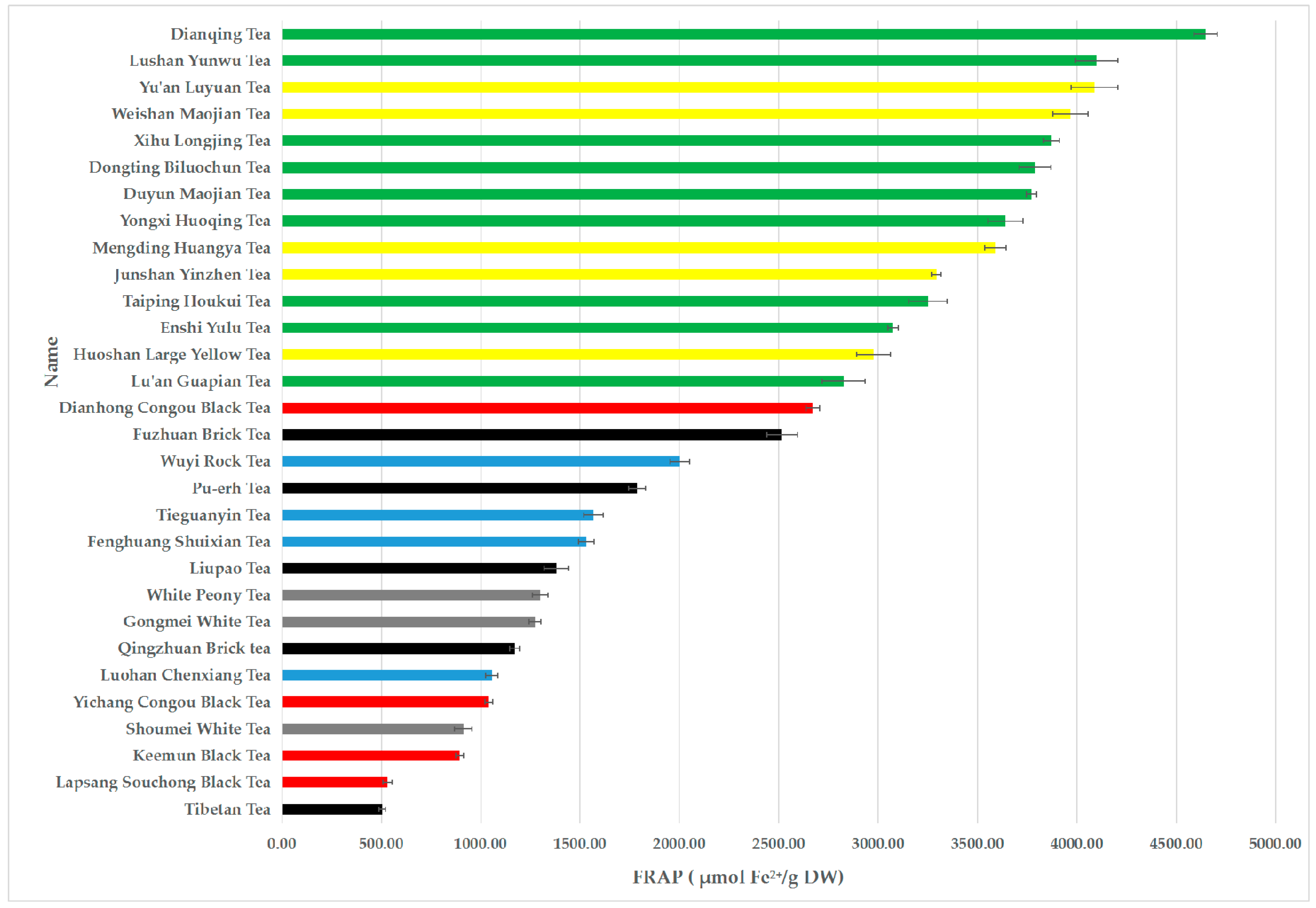
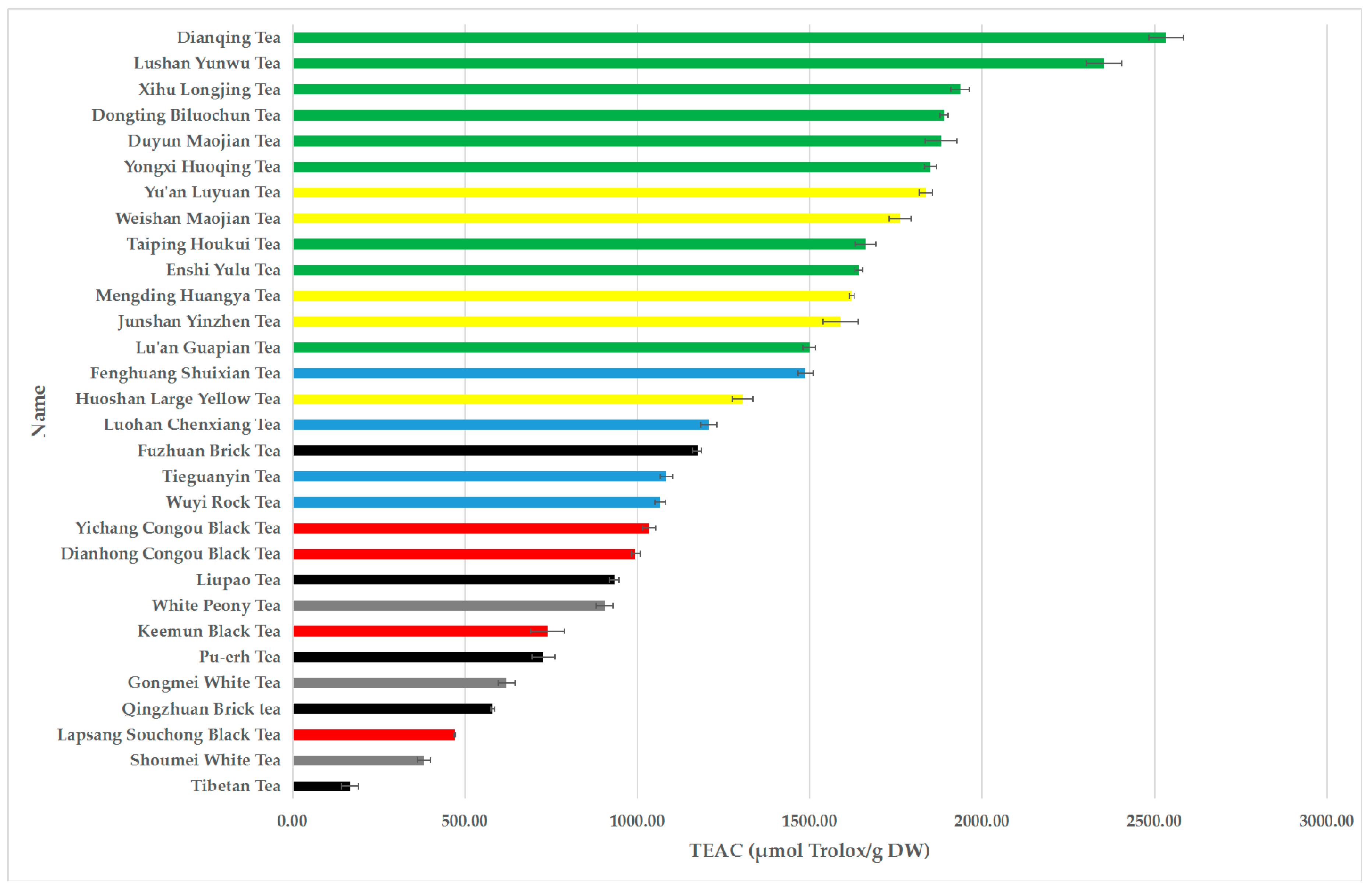
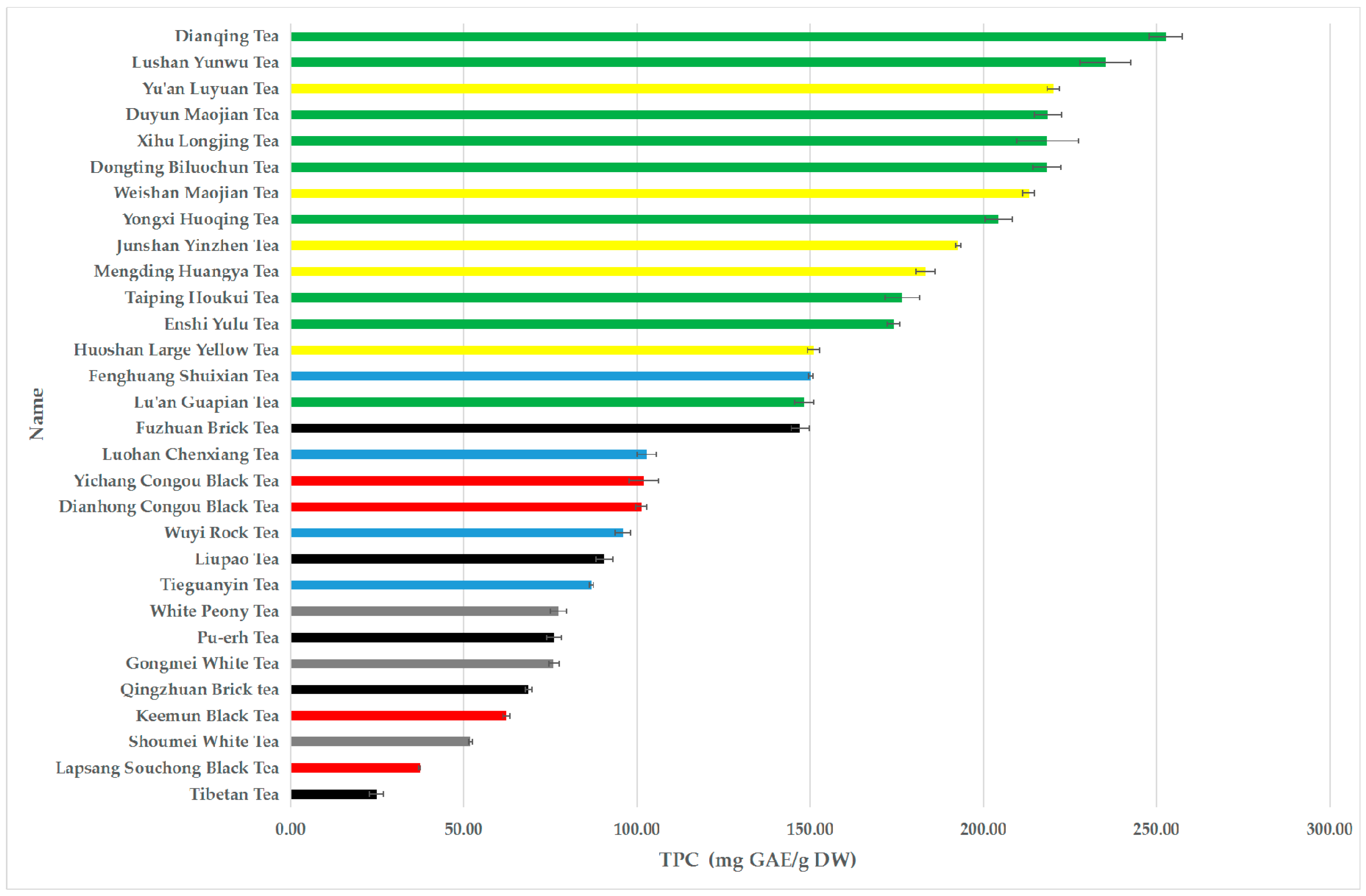
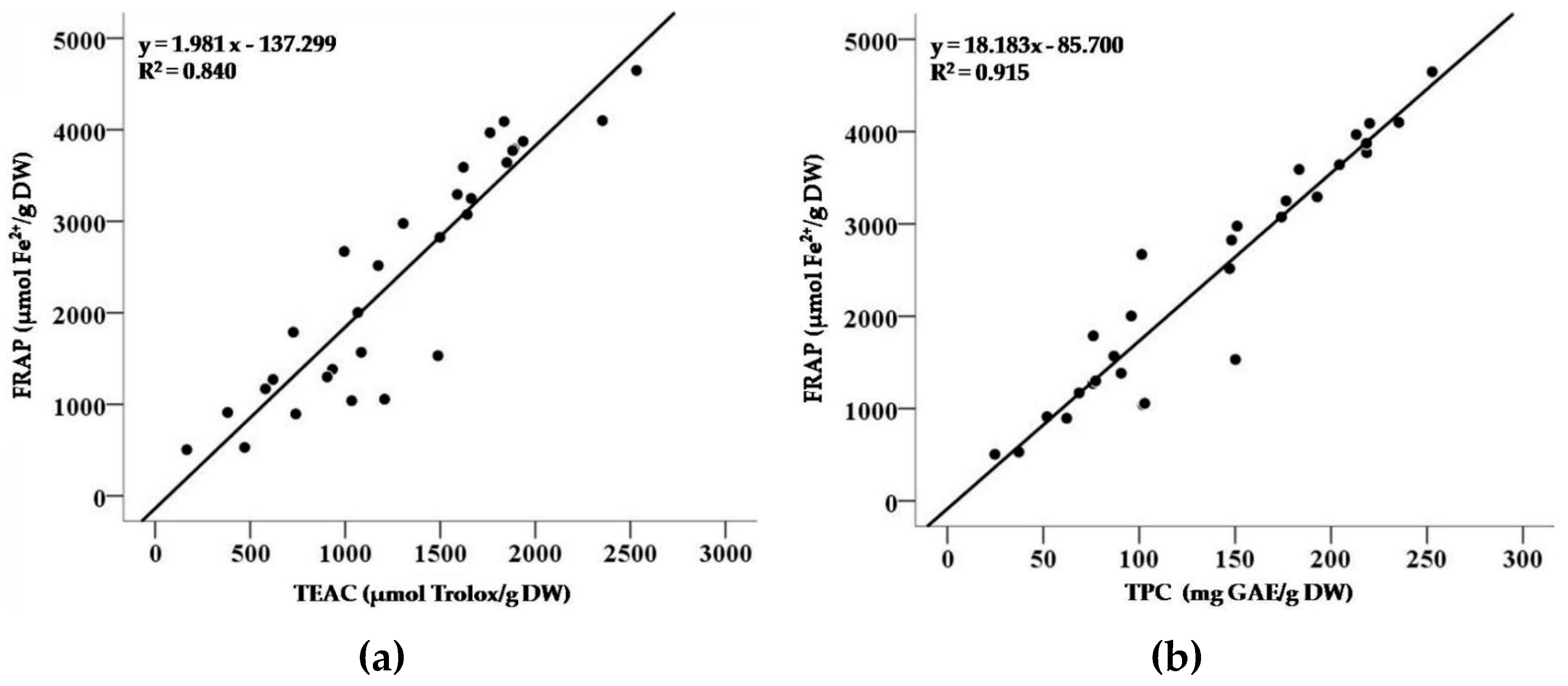
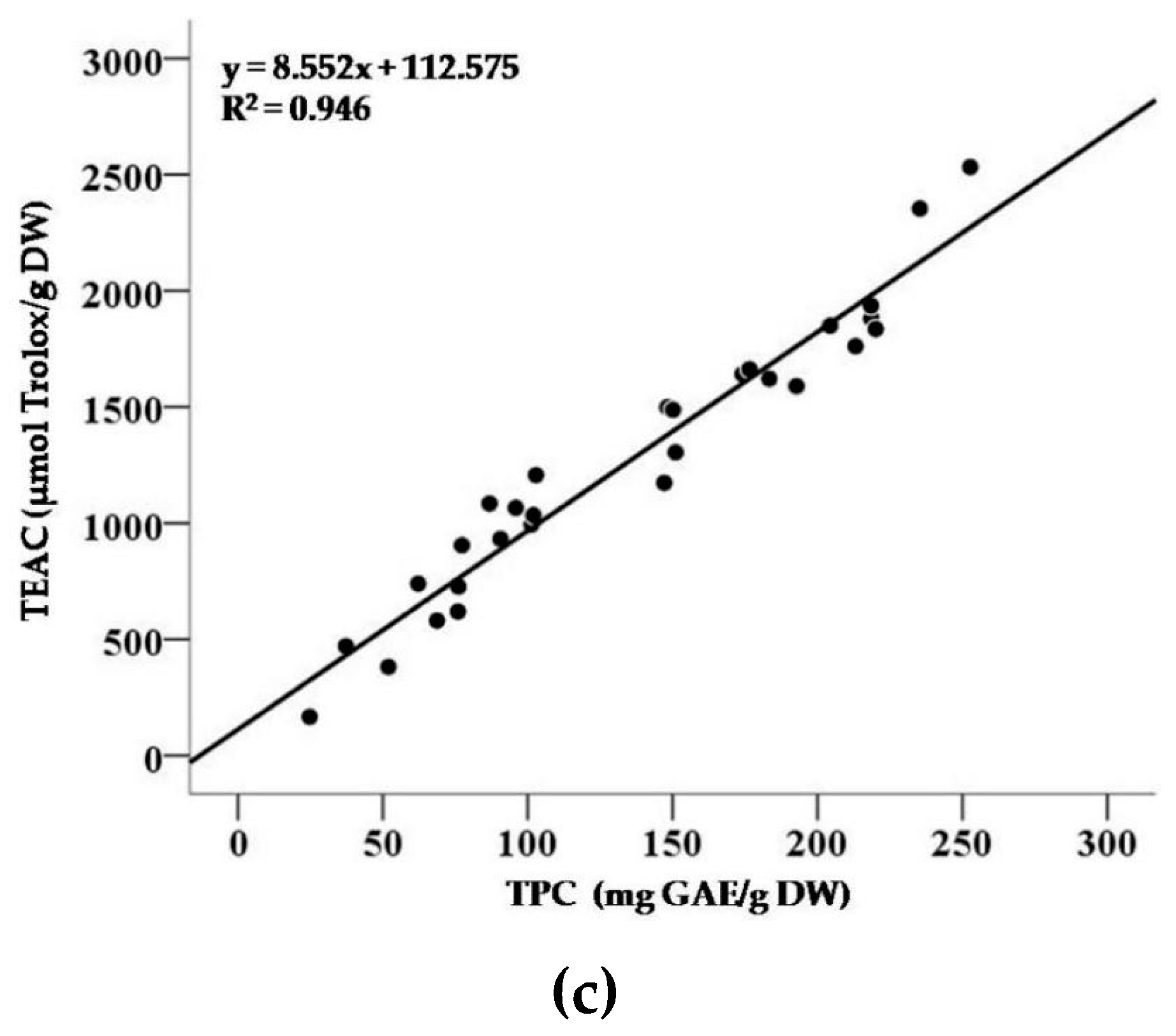
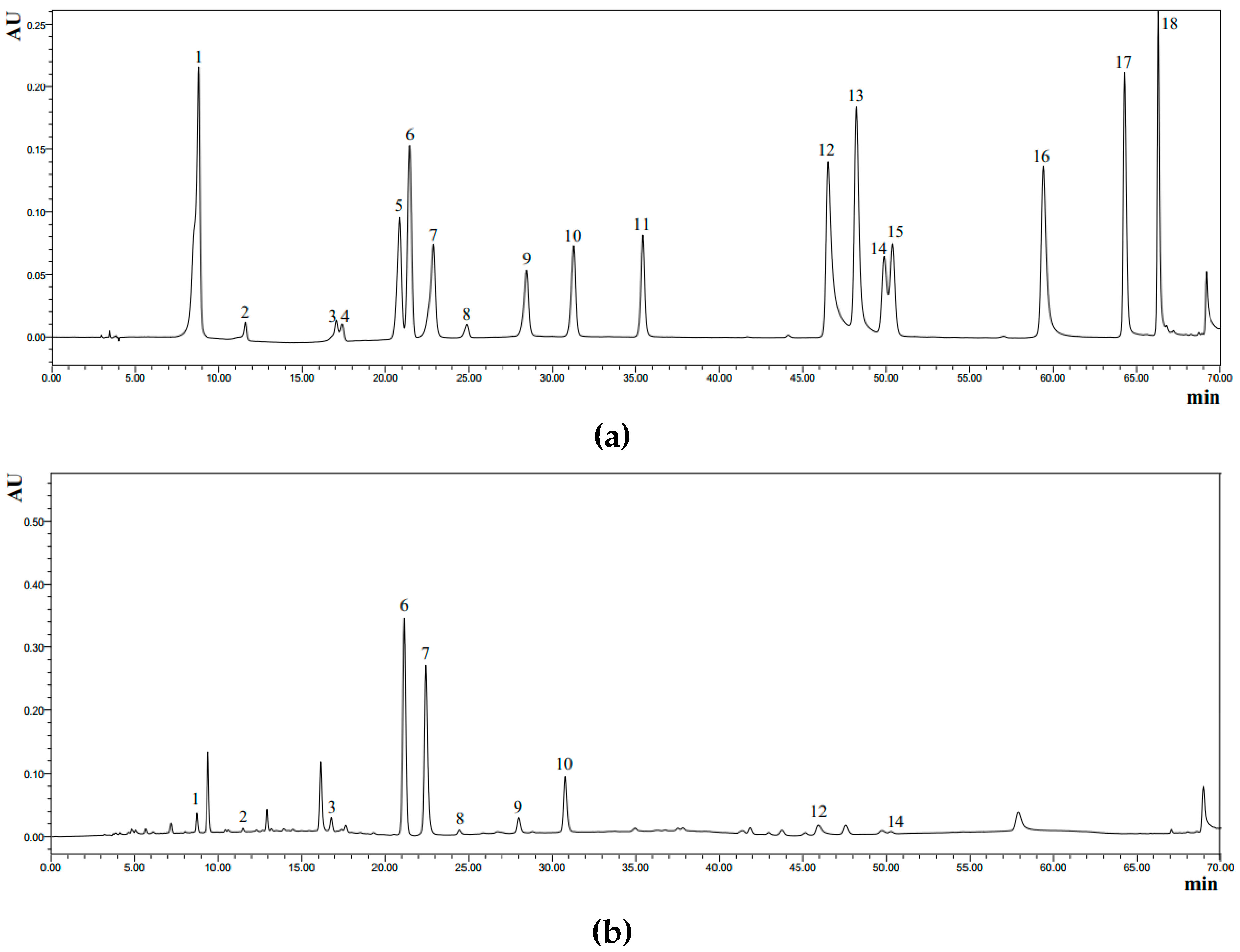
| No. | Name | Category | Place of Production | FRAP (µmol Fe2+/g DW) | TEAC (µmol Trolox/g DW) | TPC (mg GAE/g DW) |
|---|---|---|---|---|---|---|
| 1 | Dianhong Congou Black Tea | Black Tea | Kunming, Yunnan | 2670.13 ± 34.02 | 994.56 ± 12.64 | 101.29 ± 1.58 |
| 2 | Keemun Black Tea | Black Tea | Qimen, Anhui | 894.13 ± 20.13 | 739.88 ± 49.11 | 62.16 ± 0.99 |
| 3 | Lapsang Souchong Black Tea | Black Tea | Wuyishan, Fujian | 530.13 ± 23.44 | 471.17 ± 2.02 | 37.23 ± 0.28 |
| 4 | Yichang Congou Black Tea | Black Tea | Yichang, Hubei | 1039.47 ± 19.73 | 1034.29 ± 17.99 | 101.94 ± 4.14 |
| 5 | Fuzhuan Brick Tea | Dark Tea | Anhua, Hubei | 2516.80 ± 76.32 | 1173.49 ± 12.85 | 147.11 ± 2.59 |
| 6 | Liupao Tea | Dark Tea | Wuzhou, Guangxi | 1382.13 ± 62.01 | 932.64 ± 13.27 | 90.55 ± 2.46 |
| 7 | Pu-erh Tea | Dark Tea | Pu’er, Yunnan | 1787.47 ± 42.39 | 727.02 ± 33.68 | 76.08 ± 2.06 |
| 8 | Qingzhuan Brick tea | Dark Tea | Chibi, Hubei | 1170.13 ± 25.72 | 580.49 ± 5.88 | 68.65 ± 0.98 |
| 9 | Tibetan Tea | Dark Tea | Ya’an, Sichuan | 504.80 ± 17.44 | 166.29 ± 24.48 | 24.77 ± 2.02 |
| 10 | Dianqing Tea | Green Tea | Kunming, Yunnan | 4647.47 ± 57.87 | 2532.41 ± 50.18 | 252.65 ± 4.74 |
| 11 | Dongting Biluochun Tea | Green Tea | Suzhou, Jiangsu | 3788.80 ± 80.30 | 1889.22 ± 12.33 | 218.38 ± 4.00 |
| 12 | Duyun Maojian Tea | Green Tea | Duyun, Guizhou | 3771.47 ± 25.40 | 1880.54 ± 45.15 | 218.55 ± 3.90 |
| 13 | Enshi Yulu Tea | Green Tea | Enshi, Hubei | 3074.13 ± 26.03 | 1641.77 ± 10.47 | 174.10 ± 1.88 |
| 14 | Lu’an Guapian Tea | Green Tea | Lu’an, Anhui | 2824.80 ± 107.63 | 1498.51 ± 17.93 | 148.16 ± 2.72 |
| 15 | Lushan Yunwu Tea | Green Tea | Jiujiang, Jiangxi | 4099.47 ± 105.10 | 2353.21 ± 50.68 | 235.27 ± 7.28 |
| 16 | Taiping Houkui Tea | Green Tea | Huangshan, Anhui | 3250.13 ± 96.03 | 1662.39 ± 29.54 | 176.53 ± 4.97 |
| 17 | Xihu Longjing Tea | Green Tea | Hangzhou, Zhejiang | 3872.80 ± 38.16 | 1935.89 ± 26.32 | 218.46 ± 8.82 |
| 18 | Yongxi Huoqing Tea | Green Tea | Jingxian, Anhui | 3640.80 ± 89.08 | 1850.15 ± 17.93 | 204.32 ± 3.94 |
| 19 | Fenghuang Shuixian Tea | Oolong Tea | Chao’an, Guangdong | 1531.47 ± 38.85 | 1487.58 ± 21.42 | 150.10 ± 0.56 |
| 20 | Luohan Chenxiang Tea | Oolong Tea | Mengdingshan, Sichuan | 1055.47 ± 30.02 | 1207.19 ± 23.34 | 102.83 ± 2.76 |
| 21 | Tieguanyin Tea | Oolong Tea | Anxi, Fujian | 1567.47 ± 50.01 | 1084.52 ± 17.64 | 86.83 ± 0.61 |
| 22 | Wuyi Rock Tea | Oolong Tea | Wuyishan, Fujian | 2002.13 ± 47.72 | 1065.83 ± 15.80 | 95.88 ± 2.31 |
| 23 | Gongmei White Tea | White Tea | Nanping, Fujian | 1271.47 ± 29.48 | 620.10 ± 24.56 | 75.92 ± 1.46 |
| 24 | Shoumei White Tea | White Tea | Nanping, Fujian | 911.47 ± 44.06 | 381.3 ± 18.701 | 51.92 ± 0.56 |
| 25 | White Peony Tea | White Tea | Nanping, Fujian | 1299.47 ± 40.07 | 904.85 ± 24.58 | 77.29 ± 2.33 |
| 26 | Huoshan Large Yellow Tea | Yellow Tea | Lu’an, Anhui | 2975.47 ± 85.54 | 1304.76 ± 29.66 | 150.99 ± 1.79 |
| 27 | Junshan Yinzhen Tea | Yellow Tea | Yueyang, Hunan | 3292.80 ± 24.33 | 1589.95 ± 51.41 | 192.69 ± 0.74 |
| 28 | Mengding Huangya Tea | Yellow Tea | Mengdingshan, Sichuan | 3590.13 ± 54.60 | 1621.63 ± 7.07 | 183.31 ± 2.66 |
| 29 | Weishan Maojian Tea | Yellow Tea | Ningxiang, Hunan | 3967.47 ± 87.76 | 1761.96 ± 30.56 | 213.05 ± 1.61 |
| 30 | Yu’an Luyuan Tea | Yellow Tea | Yichang, Hubei | 4088.80 ± 118.39 | 1835.52 ± 19.60 | 220.08 ± 1.75 |
| Name | Catechin (mg/g DW) | Epicatechin (mg/g DW) | Gallocatechin (mg/g DW) | Epigallocatechin (mg/g DW) | Catechin gallate (mg/g DW) | Epicatechin gallate (mg/g DW) | Gallocatechin Gallate (mg/g DW) | Epigallocatechin Gallate (mg/g DW) | ||
| Dianhong Congou Black Tea | - | 1.33 ± 0.16 k,l | - | - | - | 2.72 ± 0.20 h,i | - | - | ||
| Keemun Black Tea | - | 0.45 ± 0.04 l | - | - | - | 1.12 ± 0.09 j | - | 1.34 ± 0.15 f | ||
| Lapsang Souchong Black Tea | - | - | - | - | - | - | - | - | ||
| Yichang Congou Black Tea | - | - | - | - | - | 2.69 ± 0.27 h,i | - | 2.15 ± 0.15 f | ||
| Fuzhuan Brick Tea | 3.22 ± 0.16 b | 9.60 ± 0.77 b,c | 5.78 ± 0.38 e,f,g | 17.24 ± 1.58 g,h,i,j | - | 10.92 ± 0.78 e | 1.61 ± 0.20 i | 9.56 ± 0.44 d,e,f | ||
| Liupao Tea | 1.36 ± 0.13 c | 3.76 ± 0.29 i,j | 3.12 ± 0.27 h | 3.70 ± 0.26 l | - | - | - | - | ||
| Pu-erh Tea | - | 0.83 ± 0.05 k,l | - | - | - | - | - | - | ||
| Qingzhuan Brick tea | - | 3.29 ± 0.20 j | 2.48 ± 0.14 h | 19.9 ± 1.82 g,h,i,j | - | - | 1.46 ± 0.12 i | 3.72 ± 0.26 f | ||
| Tibetan Tea | - | - | - | - | - | - | - | 0.99 ± 0.09 f | ||
| Dianqing Tea | 4.54 ± 0.34 a | 5.83 ± 0.56 f,g,h | 3.27 ± 0.24 h | 13.44 ± 1.07 j,k | 0.71 ± 0.10 c | 30.29 ± 2.87 a | 4.37 ± 0.47 g,h | 55.38 ± 5.57 a | ||
| Dongting Biluochun Tea | - | 7.05 ± 0.71 e,f,g | 5.34 ± 0.40 e,f,g | 37.42 ± 2.54 e | 0.99 ± 0.08 b | 32.12 ± 3.11 a | 5.04 ± 0.46 f,g | 52.38 ± 4.86 a | ||
| Duyun Maojian Tea | - | 9.13 ± 0.65 b,c,d | 6.28 ± 0.13 d,e,f | 47.86 ± 4.45 d | - | 22.56 ± 2.26 c,d | 7.24 ± 0.61 c,d | 56.12 ± 4.67 a | ||
| Enshi Yulu Tea | 3.51 ± 0.26 b | 6.98 ± 0.51 e,f,g | 5.10 ± 0.12 f,g | 34.59 ± 3.05 e,f | 1.01 ± 0.08 b | 18.5 ± 1.62 d | 6.15 ± 0.41 c,d,e,f | 35.01 ± 3.16 c | ||
| Lu’an Guapian Tea | - | 7.44 ± 0.77 d,e,f | 9.78 ± 0.42 a | 91.62 ± 6.25 a | - | 7.33 ± 0.69 e,f,g,h | 5.10 ± 0.45 f,g | 34.36 ± 2.56 c | ||
| Lushan Yunwu Tea | - | 9.04 ± 0.50 b,c,d | 6.37 ± 0.26 d,e | 62.56 ± 3.83 c | 0.54 ± 0.05 c | 19.08 ± 1.46 d | 7.00 ± 0.83 c,d,e | 57.56 ± 5.54 a | ||
| Taiping Houkui Tea | - | 10.59 ± 0.95 a,b | 8.88 ± 0.47 a,b | 72.73 ± 4.73 b | - | 9.03 ± 1.06 e,f | 5.44 ± 0.42 d,e,f,g | 40.89 ± 3.76 c | ||
| Xihu Longjing Tea | - | 7.10 ± 0.26 e,f,g | 5.85 ± 0.47 e,f,g | 25.58 ± 1.70 f,g,h,i | 1.46 ± 0.13 a | 24.51 ± 1.85 b,c | 9.11 ± 1.10 b | 51.85 ± 4.04 a,b | ||
| Yongxi Huoqing Tea | - | 8.56 ± 0.46 c,d,e | 4.84 ± 0.38 g | 21.44 ± 1.62 g,h,i,j | 0.53 ± 0.07 c | 20.79 ± 1.54 c,d | 5.38 ± 0.51 e,f,g | 52.77 ± 3.58 a | ||
| Fenghuang Shuixian Tea | - | 2.45 ± 0.20 j,k | 3.16 ± 0.32 h | 16.22 ± 1.06 i,j,k | - | 7.57 ± 0.51 e,f,g | 3.01 ± 0.31 h,i | 34.74 ± 3.17 c | ||
| Luohan Chenxiang Tea | - | 5.73 ± 0.54 f,g,h | 9.15 ± 0.80 a,b | 73.97 ± 7.25 b | - | 3.08 ± 0.34 g,h,i,j | 2.69 ± 0.21 h,i | 17.08 ± 1.62 d | ||
| Tieguanyin Tea | - | 9.19 ± 0.87 b,c | 7.12 ± 0.53 c,d | 71.62 ± 3.77 b,c | - | 3.08 ± 0.40 g,h,i,j | 1.56 ± 0.17 i | 10.34 ± 0.56 d,e,f | ||
| Wuyi Rock Tea | - | 3.30 ± 0.22 j | 7.91 ± 0.53 b,c | 26.28 ± 2.10 f,g,h | - | 3.51 ± 0.38 g,h,i,j | 2.69 ± 0.23 h,i | 14.01 ± 1.06 d,e | ||
| Gongmei White Tea | - | 1.07 ± 0.08 k,l | - | 6.69 ± 0.59 k,l | - | 2.37 ± 0.22 i,j | - | 4.93 ± 0.54 e,f | ||
| Shoumei White Tea | - | 0.83 ± 0.07 k,l | - | - | - | - | - | 2.11 ± 0.13 f | ||
| White Peony Tea | - | 1.35 ± 0.13 k,l | - | - | - | 2.67 ± 0.22 h,i,j | - | 5.35 ± 0.58 e,f | ||
| Huoshan Large Yellow Tea | - | 2.44 ± 0.29 j,k | 9.76 ± 0.62 a | 12.12 ± 0.93 j,k,l | - | 6.21 ± 0.53 f,g,h,i | 13.10 ± 1.17 a | 18.55 ± 2.50 d | ||
| Junshan Yinzhen Tea | 0.95 ± 0.06 c | 5.46 ± 0.49 g,h,i | 3.33 ± 0.32 h | 11.96 ± 0.62 j,k,l | - | 24.03 ± 2.18 b,c | 6.77 ± 0.53 c,d,e,f | 42.38 ± 4.32 b,c | ||
| Mengding Huangya Tea | - | 5.17 ± 0.56 h,i | 3.55 ± 0.16 h | 17.07 ± 1.54 h,i,j | 1.10 ± 0.09 b | 21.99 ± 1.56 c,d | - | 37.83 ± 3.06 c | ||
| Weishan Maojian Tea | 3.05 ± 0.11 b | 12.06 ± 1.17 a | 5.03 ± 0.26 g | 39.23 ± 2.21 d,e | - | 28.68 ± 2.60 a,b | - | 38.89 ± 4.16 c | ||
| Yuan’an Luyuan Tea | - | 6.53 ± 0.59 f,g,h | 5.65 ± 0.40 e,f,g | 26.61 ± 1.25 f,g | - | 21.38 ± 1.53 c,d | 7.32 ± 0.91 c | 54.38 ± 4.73 a | ||
| Name | Gallic Acid (mg/g DW) | Ellagic Acid (mg/g DW) | Quercitrin (mg/g DW) | Astragalin (mg/g DW) | Quercetin (mg/g DW) | Kaempferol (mg/g DW) | Chlorogenic Acid (mg/g DW) | Myricetin (mg/g DW) | Caffeine (mg/g DW) | Theaflavin (mg/g DW) |
| Dianhong Congou Black Tea | 2.65 ± 0.17 c,d | 4.57 ± 0.41 c,d | - | 1.09 ± 0.16 c | - | - | - | - | 35.09 ± 3.62 b,c,d,e,f,g,h | 0.66 ± 0.06 a |
| Keemun Black Tea | 2.87 ± 0.15 b,c,d | - | 0.65 ± 0.07 i | 0.89 ± 0.05 c,d,e | - | - | - | - | 25.07 ± 2.86 i,j,k | - |
| Lapsang Souchong Black Tea | 1.88 ± 0.08 f,g,h | 2.11 ± 0.27 h | 0.81 ± 0.09 g,h,i | 0.60 ± 0.04 d,e,f | - | - | - | - | 21.09 ± 2.09 j,k,l,m | - |
| Yichang Congou Black Tea | 3.77 ± 0.32 a | 2.78 ± 0.24 e,f,g,h | - | 3.54 ± 0.42 a | - | - | - | - | 39.55 ± 3.29 a,b,c,d,e | 0.70 ± 0.08 a |
| Fuzhuan Brick Tea | 3.22 ± 0.22 b | 2.51 ± 0.14 e,f,g,h | 1.86 ± 0.19 b | 1.75 ± 0.16 b | 0.08 ± 0.01 a | 0.19 ± 0.02 a | 0.35 ± 0.02 b,c | - | 27.8 ± 2.29 h,i,j | - |
| Liupao Tea | 2.10 ± 0.19 f,g | 2.31 ± 0.27 f,g,h | 0.79 ± 0.04 g,h,i | - | - | - | - | - | 30.98 ± 2.79 e,f,g,h,i | - |
| Pu-erh Tea | 1.23 ± 0.02 k,l,m | 2.61 ± 0.19 e,f,g,h | 0.74 ± 0.03 h,i | - | - | - | - | - | 26.58 ± 1.30 i,j,k | - |
| Qingzhuan Brick tea | 2.85 ± 0.20 b,c,d | - | - | - | - | - | - | - | 15.65 ± 1.37 m,n | - |
| Tibetan Tea | 1.52 ± 0.12 h,i,j,k,l | - | - | - | - | - | - | - | 16.32 ± 1.31 l,m,n | - |
| Dianqing Tea | 1.77 ± 0.13 g,h,i | 7.77 ± 0.70 b | - | - | - | - | 0.49 ± 0.02 a | - | 38.01 ± 2.46 b,c,d,e,f | - |
| Dongting Biluochun Tea | 1.03 ± 0.04 m | - | 1.15 ± 0.11 d,e,f,g | 1.02 ± 0.11 c,d | - | - | 0.29 ± 0.01 c,d,e | - | 32.45 ± 2.53 c,d,e,f,g,h,i | - |
| Duyun Maojian Tea | 1.32 ± 0.08 j,k,l,m | 3.50 ± 0.26 d,e | 2.53 ± 0.19 a | - | - | - | - | - | 42.20 ± 3.83 a,b | - |
| Enshi Yulu Tea | 1.80 ± 0.06 f,g,h | 3.52 ± 0.29 d,e | 1.08 ± 0.07 d,e,f,g,h | - | - | - | - | - | 38.14 ± 3.01 b,c,d,e,f | - |
| Lu’an Guapian Tea | 0.45 ± 0.02 n | - | 1.01 ± 0.11 e,f,g,h,i | - | - | - | 0.33 ± 0.02 b,c | - | 28.74 ± 2.62 g,h,i,j | - |
| Lushan Yunwu Tea | 1.24 ± 0.10 k,l,m | 3.12 ± 0.30 e,f,g,h | 2.76 ± 0.25 a | - | - | - | - | - | 47.46 ± 4.35 a | - |
| Taiping Houkui Tea | 0.58 ± 0.07 n | 2.33 ± 0.22 f,g,h | 1.22 ± 0.15 d,e,f | 0.39 ± 0.02 f | - | - | 0.35 ± 0.03 b,c | - | 32.37 ± 3.17 c,d,e,f,g,h,i | - |
| Xihu Longjing Tea | 1.63 ± 0.04 h,i,j,k | - | - | - | - | - | 0.39 ± 0.03 b | - | 36.65 ± 3.28 b,c,d,e,f,g | - |
| Yongxi Huoqing Tea | 1.36 ± 0.03 i,j,k,l,m | 3.44 ± 0.20 d,e,f | - | - | - | - | 0.34 ± 0.03 b,c | - | 31.77 ± 2.50 c,d,e,f,g,h,i | - |
| Fenghuang Shuixian Tea | 3.05 ± 0.14 b,c | 2.29 ± 0.16 g,h | 1.65 ± 0.12 b,c | 1.22 ± 0.06 c | - | - | 0.24 ± 0.01 d,e | - | 31.66 ± 1.97 d,e,f,g,h,i | - |
| Luohan Chenxiang Tea | 0.59 ± 0.02 n | - | 1.28 ± 0.13 c,d,e | 0.63 ± 0.07 d,e,f | - | - | 0.30 ± 0.02 c,d | - | 24.88 ± 1.65 i,j,k | - |
| Tieguanyin Tea | 0.29 ± 0.02 n | 2.15 ± 0.20 h | 0.95 ± 0.05 e,f,g,h,i | - | - | - | 0.23 ± 0.02 e | - | 12.36 ± 1.18 n | - |
| Wuyi Rock Tea | 1.35 ± 0.08 i,j,k,l,m | 2.10 ± 0.20 h | - | - | - | - | - | - | 19.28 ± 1.26 k,l,m,n | - |
| Gongmei White Tea | 2.57 ± 0.02 d,e | 2.30 ± 0.21 g,h | 0.89 ± 0.05 f,g,h,i | - | - | - | - | - | 27.54 ± 1.83 h,i,j,k | - |
| Shoumei White Tea | 2.09 ± 0.07 f,g | - | - | 0.36 ± 0.05 f | - | - | - | - | 24.52 ± 2.18 i,j,k,l | - |
| White Peony Tea | 2.71 ± 0.10 c,d | 2.35 ± 0.10 f,g,h | 0.94 ± 0.05 e,f,g,h,i | 0.50 ± 0.05 e,f | - | 0.17 ± 0.02 a | 0.26 ± 0.02 d,e | - | 30.64 ± 2.92 f,g,h,i | - |
| Huoshan Large Yellow Tea | 3.16 ± 0.26 b | 2.39 ± 0.25 e,f,g,h | 0.89 ± 0.08 f,g,h,i | - | 0.01 ± 0.00 b | 0.19 ± 0.01 a | - | - | 32.51 ± 2.20 c,d,e,f,g,h,i | - |
| Junshan Yinzhen Tea | 1.19 ± 0.06 l,m | 3.29 ± 0.13 e,f,g | 1.43 ± 0.14 c,d | - | - | - | 0.35 ± 0.02 b,c | - | 38.66 ± 2.50 b,c,d,e,f | - |
| Mengding Huangya Tea | 2.22 ± 0.17 e,f | 9.79 ± 1.01 a | - | - | - | - | - | - | 35.61 ± 3.25 b,c,d,e,f,g,h | - |
| Weishan Maojian Tea | 1.22 ± 0.04 k,l,m | 4.48 ± 0.45 c,d | - | - | - | - | 0.33 ± 0.01 b,c | - | 39.64 ± 2.89 a,b,c,d | - |
| Yu’an Luyuan Tea | 1.73 ± 0.16 g,h,i,j | 4.77 ± 0.44 c | - | - | - | - | 0.34 ± 0.03 b,c | - | 40.22 ± 3.17 a,b,c | - |
© 2019 by the authors. Licensee MDPI, Basel, Switzerland. This article is an open access article distributed under the terms and conditions of the Creative Commons Attribution (CC BY) license (http://creativecommons.org/licenses/by/4.0/).
Share and Cite
Zhao, C.-N.; Tang, G.-Y.; Cao, S.-Y.; Xu, X.-Y.; Gan, R.-Y.; Liu, Q.; Mao, Q.-Q.; Shang, A.; Li, H.-B. Phenolic Profiles and Antioxidant Activities of 30 Tea Infusions from Green, Black, Oolong, White, Yellow and Dark Teas. Antioxidants 2019, 8, 215. https://doi.org/10.3390/antiox8070215
Zhao C-N, Tang G-Y, Cao S-Y, Xu X-Y, Gan R-Y, Liu Q, Mao Q-Q, Shang A, Li H-B. Phenolic Profiles and Antioxidant Activities of 30 Tea Infusions from Green, Black, Oolong, White, Yellow and Dark Teas. Antioxidants. 2019; 8(7):215. https://doi.org/10.3390/antiox8070215
Chicago/Turabian StyleZhao, Cai-Ning, Guo-Yi Tang, Shi-Yu Cao, Xiao-Yu Xu, Ren-You Gan, Qing Liu, Qian-Qian Mao, Ao Shang, and Hua-Bin Li. 2019. "Phenolic Profiles and Antioxidant Activities of 30 Tea Infusions from Green, Black, Oolong, White, Yellow and Dark Teas" Antioxidants 8, no. 7: 215. https://doi.org/10.3390/antiox8070215
APA StyleZhao, C.-N., Tang, G.-Y., Cao, S.-Y., Xu, X.-Y., Gan, R.-Y., Liu, Q., Mao, Q.-Q., Shang, A., & Li, H.-B. (2019). Phenolic Profiles and Antioxidant Activities of 30 Tea Infusions from Green, Black, Oolong, White, Yellow and Dark Teas. Antioxidants, 8(7), 215. https://doi.org/10.3390/antiox8070215






